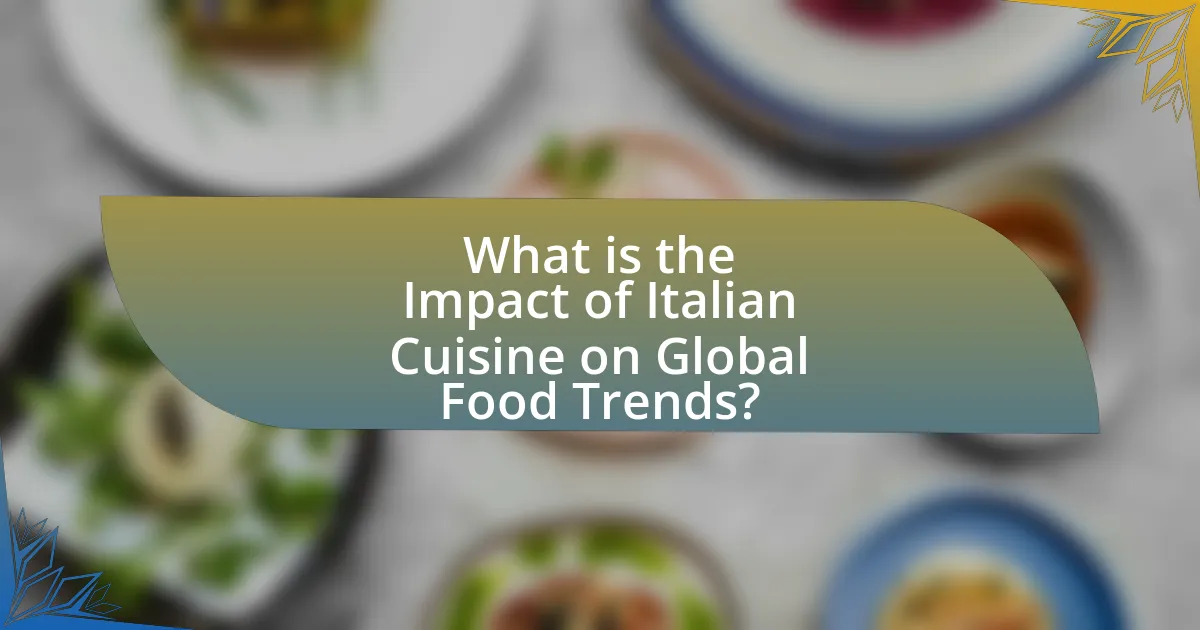Italian cuisine plays a pivotal role in shaping global food trends through its emphasis on fresh ingredients, regional specialties, and traditional cooking techniques. The widespread popularity of dishes such as pizza and pasta highlights its influence, as these staples have been integrated into various cultures worldwide. Key elements like olive oil and diverse sauces have become essential in international culinary practices, while traditional methods inspire contemporary dining experiences. Additionally, the adaptability of Italian cuisine to local tastes and the emergence of fusion dishes reflect its ongoing impact on food identity and culinary innovation across the globe.

What is the Impact of Italian Cuisine on Global Food Trends?
Italian cuisine significantly influences global food trends by promoting the use of fresh ingredients, regional specialties, and traditional cooking techniques. This impact is evident in the widespread popularity of dishes such as pizza and pasta, which have become staples in various cultures worldwide. The Italian emphasis on quality ingredients and simplicity has led to a rise in farm-to-table movements and the popularity of Mediterranean diets, which are associated with health benefits. Additionally, Italian culinary practices have inspired global chefs to adopt techniques like slow cooking and the use of seasonal produce, further shaping contemporary dining experiences.
How has Italian cuisine influenced culinary practices worldwide?
Italian cuisine has significantly influenced culinary practices worldwide by introducing foundational elements such as pasta, pizza, and a variety of sauces that have become staples in many cultures. The global popularity of Italian dishes is evidenced by the proliferation of Italian restaurants and the incorporation of Italian ingredients, like olive oil and tomatoes, into diverse culinary traditions. For instance, the introduction of pizza to the United States in the late 19th century led to its adaptation and commercialization, resulting in a multi-billion dollar industry. Additionally, Italian cooking techniques, such as al dente pasta preparation and the use of fresh herbs, have been widely adopted, shaping cooking styles across continents. The influence of Italian cuisine is further highlighted by the global success of Italian culinary schools, which train chefs in traditional methods, thereby perpetuating its impact on international gastronomy.
What are the key elements of Italian cuisine that have gained global popularity?
The key elements of Italian cuisine that have gained global popularity include pasta, pizza, olive oil, and regional sauces. Pasta, with its diverse shapes and preparations, is a staple in many cultures, often served with various sauces like marinara and pesto, which originated in Italy. Pizza, particularly the Neapolitan style, has become a worldwide favorite, characterized by its thin crust and simple toppings. Olive oil, a fundamental ingredient in Italian cooking, is celebrated for its health benefits and flavor, making it a common choice in kitchens around the globe. These elements have influenced culinary practices worldwide, as evidenced by the proliferation of Italian restaurants and the incorporation of Italian ingredients in various cuisines.
How do traditional Italian cooking techniques shape modern culinary trends?
Traditional Italian cooking techniques significantly influence modern culinary trends by emphasizing fresh ingredients, simplicity, and regional diversity. These techniques, such as slow cooking, handmade pasta, and the use of seasonal produce, promote a focus on quality over quantity, which resonates with contemporary movements like farm-to-table and artisanal food production. For instance, the Italian practice of using local ingredients has inspired chefs worldwide to prioritize sourcing from local farms, thereby enhancing flavor and sustainability in their dishes. Additionally, the popularity of Italian dishes like pizza and risotto has led to their adaptation and reinterpretation in various global cuisines, showcasing the lasting impact of these traditional methods on modern culinary practices.
Why is Italian cuisine considered a benchmark for global food trends?
Italian cuisine is considered a benchmark for global food trends due to its emphasis on fresh, high-quality ingredients and its influence on culinary practices worldwide. The principles of Italian cooking, such as simplicity and the use of seasonal produce, have inspired chefs and home cooks alike, leading to the widespread adoption of these techniques in various cuisines. Additionally, iconic dishes like pizza and pasta have transcended cultural boundaries, becoming staples in many countries. The global popularity of Italian restaurants and the proliferation of Italian food products, such as olive oil and balsamic vinegar, further solidify its status as a culinary standard.
What role does Italian cuisine play in the evolution of international gastronomy?
Italian cuisine significantly influences the evolution of international gastronomy by introducing foundational cooking techniques, diverse ingredients, and flavor profiles that have been adopted globally. The use of fresh ingredients, such as tomatoes, olive oil, and herbs, has shaped culinary practices worldwide, promoting the farm-to-table movement. Additionally, Italian cooking methods, including pasta-making and pizza preparation, have become staples in various cultures, leading to the proliferation of Italian restaurants and adaptations in local cuisines. The global popularity of Italian dishes, evidenced by the presence of over 25,000 Italian restaurants in the United States alone, highlights its impact on food trends and dining experiences across different regions.
How do Italian food products contribute to global culinary standards?
Italian food products significantly contribute to global culinary standards by setting benchmarks for quality, authenticity, and flavor profiles. The use of high-quality ingredients, such as San Marzano tomatoes and Parmigiano-Reggiano cheese, exemplifies the emphasis on sourcing and production methods that prioritize taste and tradition. These products have influenced culinary practices worldwide, leading to the adoption of techniques like slow cooking and the importance of fresh, seasonal ingredients. Furthermore, the global popularity of Italian dishes, such as pasta and pizza, has established a standard for preparation and presentation that many cuisines aspire to emulate, thereby shaping international culinary trends.
What are the cultural implications of Italian cuisine on global food trends?
Italian cuisine significantly influences global food trends by promoting the values of fresh ingredients, regional diversity, and communal dining. This culinary tradition emphasizes the use of high-quality, locally sourced ingredients, which has led to a broader appreciation for farm-to-table practices worldwide. Additionally, the regional variations within Italian cuisine, such as Neapolitan pizza and Tuscan pasta, inspire chefs globally to explore and celebrate local flavors, fostering culinary creativity. The communal aspect of Italian dining, where meals are shared among family and friends, has also encouraged a shift towards more social eating experiences in various cultures, enhancing the importance of food as a means of connection. These cultural implications are evident in the rise of Italian restaurants and the incorporation of Italian dishes into diverse culinary landscapes, reflecting a global embrace of Italian culinary principles.
How does Italian cuisine reflect cultural exchange in the food industry?
Italian cuisine reflects cultural exchange in the food industry through its incorporation of diverse ingredients and cooking techniques from various cultures. This is evident in the use of tomatoes, which originated in the Americas, and their integration into traditional Italian dishes like pasta sauces. Additionally, the popularity of Italian food worldwide has led to adaptations that blend local flavors and practices, such as the creation of sushi pizza in Japan or the use of local cheeses in Italian-American dishes. These examples illustrate how Italian cuisine serves as a canvas for cultural fusion, showcasing the interconnectedness of global culinary practices.
What impact does Italian cuisine have on food identity in different regions?
Italian cuisine significantly shapes food identity across various regions by reflecting local ingredients, traditions, and cultural influences. Each Italian region showcases distinct culinary practices that highlight its agricultural products and historical context; for example, the use of seafood in coastal areas like Sicily contrasts with the hearty, meat-based dishes found in the northern regions such as Lombardy. This regional diversity not only preserves local food heritage but also fosters a sense of community and belonging among residents. Furthermore, Italian cuisine has influenced global food trends, as seen in the widespread popularity of pizza and pasta, which have been adapted and integrated into diverse culinary landscapes worldwide. This adaptability underscores the profound impact of Italian cuisine on both local and global food identities.
How does Italian cuisine adapt to local tastes around the world?
Italian cuisine adapts to local tastes around the world by incorporating regional ingredients and flavors, resulting in unique variations of traditional dishes. For example, in the United States, Italian-American cuisine features items like pizza with a thicker crust and sweeter tomato sauce, reflecting local preferences. In Brazil, Italian dishes often include local ingredients such as palm hearts and tropical fruits, showcasing a blend of Italian techniques with Brazilian flavors. This adaptability is supported by the global popularity of Italian food, which has led to the emergence of localized versions that cater to diverse palates, as evidenced by the proliferation of Italian restaurants worldwide that modify recipes to suit local tastes.
What are the emerging trends in Italian cuisine globally?
Emerging trends in Italian cuisine globally include a focus on regional authenticity, plant-based adaptations, and sustainable practices. The emphasis on regional authenticity reflects a growing consumer interest in traditional recipes and local ingredients, as seen in the popularity of dishes like Neapolitan pizza and Tuscan ribollita. Plant-based adaptations are gaining traction, with chefs creating vegan versions of classic Italian dishes, such as cashew-based creamy sauces and lentil bolognese, catering to the increasing demand for vegetarian and vegan options. Additionally, sustainable practices are becoming integral, with restaurants prioritizing locally sourced ingredients and reducing food waste, aligning with global movements towards environmental responsibility. These trends are supported by market research indicating a 20% increase in plant-based food consumption in Italy from 2019 to 2022, highlighting the shift in consumer preferences.
How are chefs innovating traditional Italian dishes for modern palates?
Chefs are innovating traditional Italian dishes for modern palates by incorporating global flavors, utilizing alternative ingredients, and emphasizing health-conscious options. For instance, many chefs are blending classic recipes with Asian spices or South American ingredients, creating fusion dishes that appeal to contemporary tastes. Additionally, the use of gluten-free pasta and plant-based proteins in traditional recipes caters to dietary preferences and restrictions, reflecting a shift towards healthier eating. This approach not only preserves the essence of Italian cuisine but also adapts it to meet the evolving demands of today’s diners, demonstrating the cuisine’s versatility and relevance in a global food landscape.
What fusion cuisines are emerging from the influence of Italian food?
Emerging fusion cuisines influenced by Italian food include Italian-Mexican, Italian-Asian, and Italian-American. Italian-Mexican cuisine combines traditional Italian ingredients like pasta with Mexican flavors, resulting in dishes such as lasagna tacos. Italian-Asian fusion incorporates elements like soy sauce and ginger into classic Italian recipes, creating unique offerings like sushi pizza. Italian-American cuisine, which has evolved in the United States, blends Italian cooking techniques with local ingredients, leading to popular dishes like chicken parmesan and spaghetti and meatballs. These fusion cuisines reflect the adaptability and global appeal of Italian culinary traditions.
What practical tips can be derived from the impact of Italian cuisine on global food trends?
Italian cuisine emphasizes fresh ingredients, simplicity, and regional diversity, which can guide global food trends. To incorporate these principles, focus on using high-quality, seasonal produce to enhance flavor and nutrition. Additionally, adopting a minimalist approach in recipes can highlight the natural tastes of ingredients, as seen in traditional Italian dishes like Caprese salad. Furthermore, embracing regional specialties can inspire culinary creativity and authenticity, reflecting the diverse cultural heritage of Italy. This approach aligns with the growing consumer preference for authentic and sustainable food experiences, as evidenced by the rise in popularity of Italian restaurants and cooking classes worldwide.















